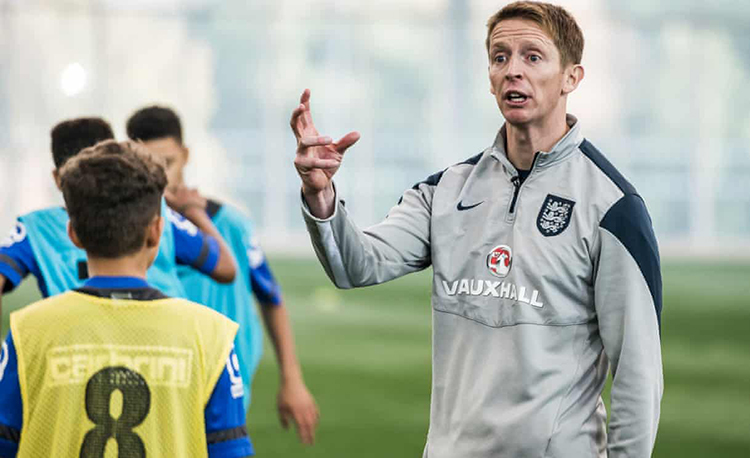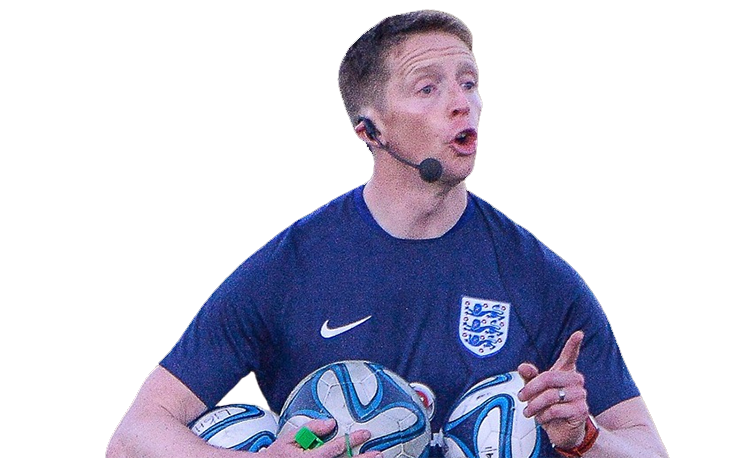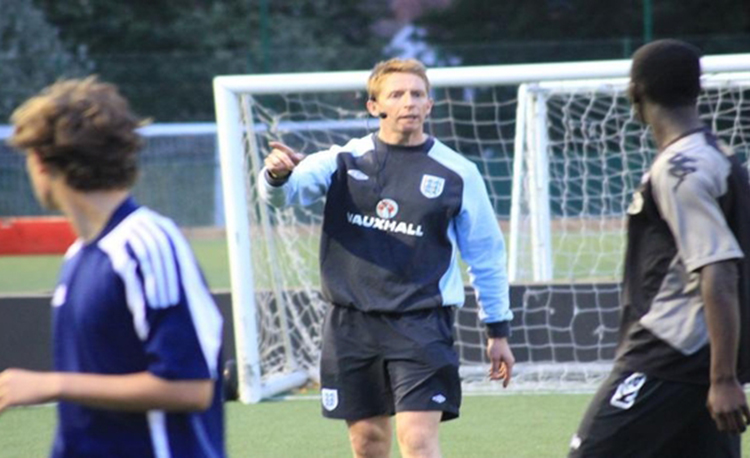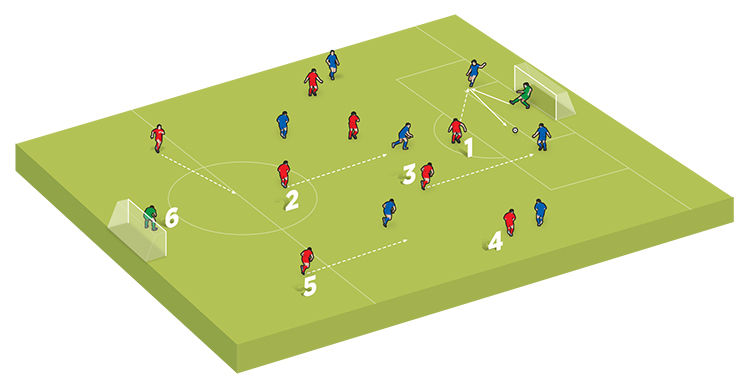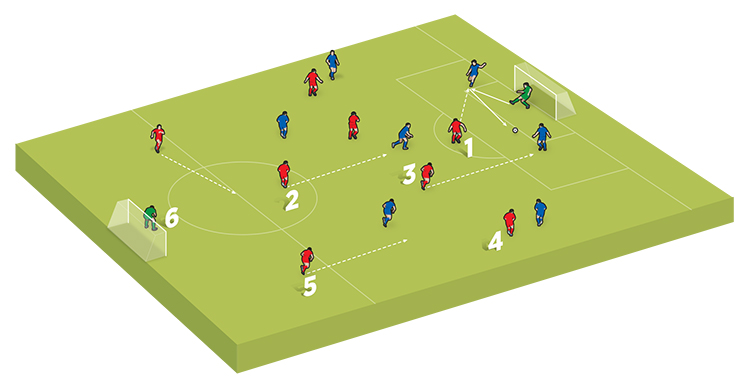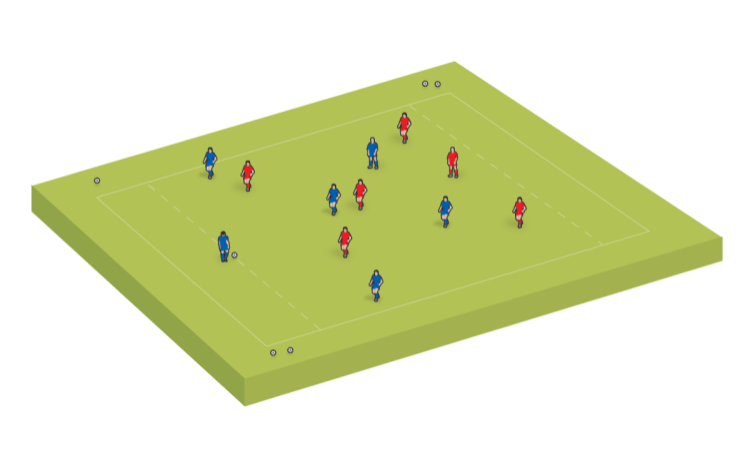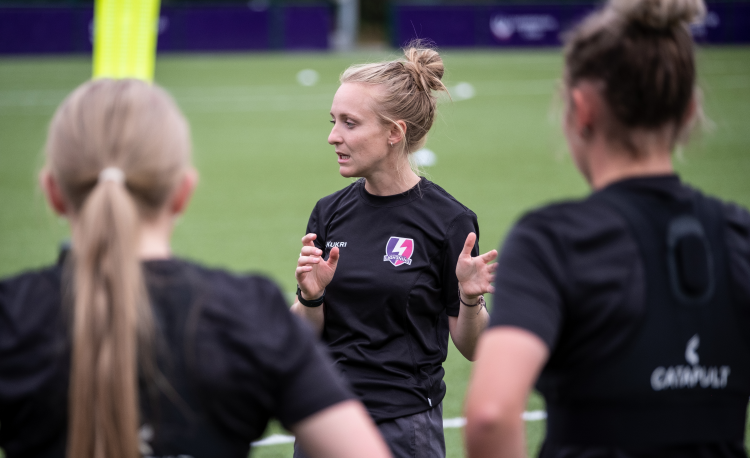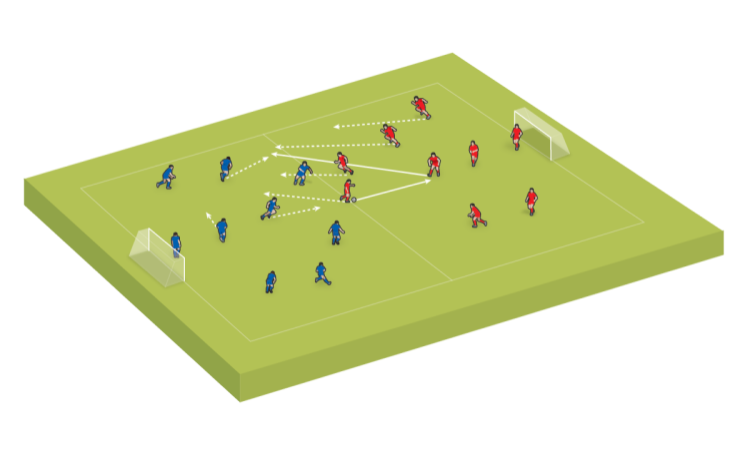Build up attacks and how to defend them
In his latest article, Fulham’s BEN BARTLETT outlines in detail another larger-numbered game to encourage players to consider a club’s desired style of play
As I wrote in my last article (SCW Jul 1), there is value in designing practices and game experiences that connect to the agreed commitments that underpin the kind of club, or team, we are.
These are blended with our holistic understanding of the players in our care and then, over time, layer in complexity.
This relinquishes a central syllabus control while reducing our need to deconstruct the game into a curriculum that looks like a school timetable.
In the last article, we introduced a game scenario which focused on larger-numbered practices, integrating our connected human systems with previous, recent practice exposure that stirred seamlessly into our agreed team and individual commitments.
Here we look at a second game (pitch above), which affords players a continued opportunity to focus attention on how to build up attacks and how to defend them across all areas of the pitch.
As opposed to the first game, this one is designed on a wide pitch rather than a long one, to enable greater opportunity for, mainly, the Blues to focus their attention on switching play and moving the ball horizontally to open up what might be called the ‘weak side of the pitch’ for the Reds.
More implicitly, players are likely to move the ball wide and across the pitch as this is where the space is likely to be. This is because the pitch is relatively short and consequently there is less space between the opposition’s vertical lines (up and down the pitch).
"The game is 9v8 in favour of the Reds, to embolden them to be hugely aggressive..."
This is, perhaps, part of the value in repeating similar practices in varying circumstances; enabling players to develop further layers within their playing abilities.
Within this notion, the players feel and sense the differences, yet get the opportunity to experience the game of soccer in the way it was inherently designed.
This game illustration is another example of blending multiple game elements, holistically, in tune with the cares and characteristics of the individual players.
The principles from the first larger- numbered game, in the July 1 issue, are inherent within this second game. The Blues sustain and continue to be exposed in ways that affords them the opportunity to heighten attention on their build-up and attacking play, while the Reds retain a greater association to defending and pressing to regain.
However, the playing systems have changed to enable the players to experience some difference.
The Blues have seven outfield players, in a 4-3, to reflect the defensive and midfield units from a 4-3-3. They have no forwards - the two advanced midfielders are being supported to develop their advanced movement due to the way the game is constrained.
The Reds reflect a 4-1-4-1, but with the central defenders removed from their set-up.
This means the game is 9v8 in favour of the Reds, to embolden them to be hugely aggressive and, in every sense of our human tendencies, overload the Blues who will, within some fairly hostile parameters, seek to play through, around or over the press.
While all players are positioned and organised to connect, in some ways, to what we understand about them as soccer players; there are some with a more acute focus:
Related Files
Player 1 (see graphic): Learning as a central forward how to ‘steer’ their team’s defending and make decisions relative to the situations.
In this game, the left-sided centre back for the Blues is right-footed, so Player 1 is encouraged to ensure the first pass from the goalkeeper goes to the Blues’ right-sided centre back (as per the graphic on the next page), which leaves the left-sided centre-back open for the switch.
Player 3: An advanced midfielder recognising when to release onto the opposition centre-back and committing to run hard to force the regain.
Shifting the playing formation to include two advanced midfielders supports this player to be aggressive. They can balance their position to one side of the pitch due to the other advanced midfielder being able to defend the opposite side.
While a big element of their practice is on pressing to release, this shouldn’t be cavalier. The timing and angle of their movement needs to prevent the Blues playing a bounce pass through one of their three midfielders.
Players 2, 4 and 5: There is an inherent connection between what different players are practising. The notion that players can be working at different elements of the game in an unassociated way is problematic.
Player 1 and 3’s movements in steering play, releasing to press and being purposeful and aggressive in seeking to regain need to be supported by the other players.
These deeper players who seem perhaps more removed from direct influence are consistently influencing the ball and other players. It’s impossible for them not to.
Players 2, 4 & 5 are also practising what might be perceived as 1v1 skills, just within a wider landscape. They have their attention focused on marking ball-side, deciding when to position themselves in front of their opponent and when to stay goal-side.
"It is inevitable the Blues will break the press and outnumber deeper players..."
At times, standing in front of an opponent, while perhaps leaving them free to explore the space nearer to our goal, can prevent bounce passes that central midfielders can receive and deal with if we follow the tradition of marking only goal-side.
This does require a will and fortitude to recover quickly to deal with their direct opponent in the likely event that, at times, the opposition choose not to play through the press but instead play over it.
The perceived 1v1 interactions that these players are engaged with, again, cover many different facets of human learning.
There is likely to be physical contact between players, due to the intense, compact nature of the way the Reds are pressing - which will require players to learn to control their body and feel the emotions that come from these combative types of situations.
This can be more deeply considered by how we match players. Players who experience strong emotional feelings in these moments can benefit from playing against opponents who are bigger, older, quicker and/or inherently calmer while being supported to explore solutions that can help them when they are an underdog.
Match-ups of these kinds can be complementary to the uneven numbered nature of this particular game. We might even-out some of that overload by creating some relative mismatches in the 1v1s, comfortable in the knowledge the underdogs may have to work together, beyond their direct 1v1s, to generate some success.
These might be some of the individual player development planning considerations that align themselves to the whole team tactics that are connecting within this and every game we play with the players.
When we utilise games as central learning opportunities, the natural flow they create enables players to experience multiple elements of the game in relative unison.
It is inevitable in this, and many games, that, at times, the Blues will break the press and be able to drive onto and even outnumber our deeper players.
This need not be deemed a problem. If the Blues find some consistent holes to expose, it is likely to inform how we support the players’ learning; however, the deepest Blues midfielder wriggling free of their marker and driving with their other two midfielders onto the two Red defenders is an opportunity for those players to practise these situations within the inherent laws and integrated identity of the game.
This is an opportunity, not an obstruction. The players have the opportunity to practice both the attacking and defending skills associated to these kind of 3v2 situations.
However, it isn’t an isolated, overly repeated 3v2. It will, inevitably, be influenced by other players from both the attacking and defending team that join (or are eliminated from) that perceived 3v2 to ensure this situation isn’t fixed, but fluid.
Diminishing the dichotomy that is epitomised by the perception that we either run a programme that is more individual OR one that is more team focused is perhaps more human and in tune with soccer.
It doesn’t need to be one or the other – it can be both. We can renounce these peremptory perspectives with approaches that connect the individual within the team.
Rather than nailing our colours to a particular mast that risks over-constraining our thinking and the players broader development, we can influence a more inclusive, less ideological, approach.
The examples within this game highlights some ways we might think about and commit to making this connection between the individual and the team.
Playing free-flowing games also helps us to connect the initial focus with these individual players within the Red team to what happens when we win the ball back. This brings player 6, the goalkeeper, into sharper focus.
Player 6: Increasingly, partly through law changes (such as the backpass law and outfield players being allowed in the area at goal-kicks) and partly through their evolving role, goalkeepers’ abilities to defend spaces outside the penalty area and support the team in possession are increasingly appearing within the vista.
The ways this game is constrained offers opportunities for goalkeepers at different ends of the pitch the opportunity to practice some things to a greater extent than others.
This is a strategic, not random, positioning of a goalkeeper for the Reds, who is developing skills to defend the spaces behind their defensive line, made even more acute by the fact this team has no centre-backs, leaving a larger space to defend.
This means the goalkeeper and full-backs working in a connected, collaborative way to manage that space while enabling the full-backs to not over-cover by playing too deep and/or too narrow.
"One team has no centre-backs, leaving a larger space for the ’keeper to defend..."
The final aspect to consider relevant to the goalkeeper is how the Reds use the ball on the regain. A task constraint that encourages players to relate the decision they make to the situation they find themselves in adds further depth within this particular game.
This task constraint is ’Get to five passes or get a goal’. In the context of this practice, concise communication can support players to decide how to play on the regain.
At times, on the regain, we might wish to generate some control of the pitch, ball and game, hence players attempt to complete a minimum of five passes when they regain.
Releasing the ball back to the ’keeper can be useful to support this, as the goalkeeper can slow the game down, draw the opposition on and has the chance to practice passing, clipping and driving the ball.
At other moments, going to goal directly on the turnover may be more appropriate. This is likely to be affected by the score, how stretched the opposition are and the nature of pressure around the ball on the turnover.
In this, the second of what will be three, larger-numbered games explored within this series, attention has been focused on connecting the nature of individual players and the things they are practising to the team intentions as a commitment to articulate how the two things aren’t mutually exclusive, dichotomised or in conflict with each other.
We also don’t need to separate the perceived psychological challenges of creating and dealing with intense defensive pressure from the football decisions or the physical demands.
They are connected parts of the same things - we should consider and practise them, both through training sessions and gamedays, in a connected, integrated way.
Separation and siloes are in school, not soccer. SCW
Newsletter Sign Up
Coaches Testimonials

Gerald Kearney, Downtown Las Vegas Soccer Club

Paul Butler, Florida, USA

Rick Shields, Springboro, USA

Tony Green, Pierrefonds Titans, Quebec, Canada
Subscribe Today
Discover the simple way to become a more effective, more successful soccer coach
In a recent survey 89% of subscribers said Soccer Coach Weekly makes them more confident, 91% said Soccer Coach Weekly makes them a more effective coach and 93% said Soccer Coach Weekly makes them more inspired.
*includes 3 coaching manuals
Get Weekly Inspiration
All the latest techniques and approaches
Soccer Coach Weekly offers proven and easy to use soccer drills, coaching sessions, practice plans, small-sided games, warm-ups, training tips and advice.
We've been at the cutting edge of soccer coaching since we launched in 2007, creating resources for the grassroots youth coach, following best practice from around the world and insights from the professional game.
